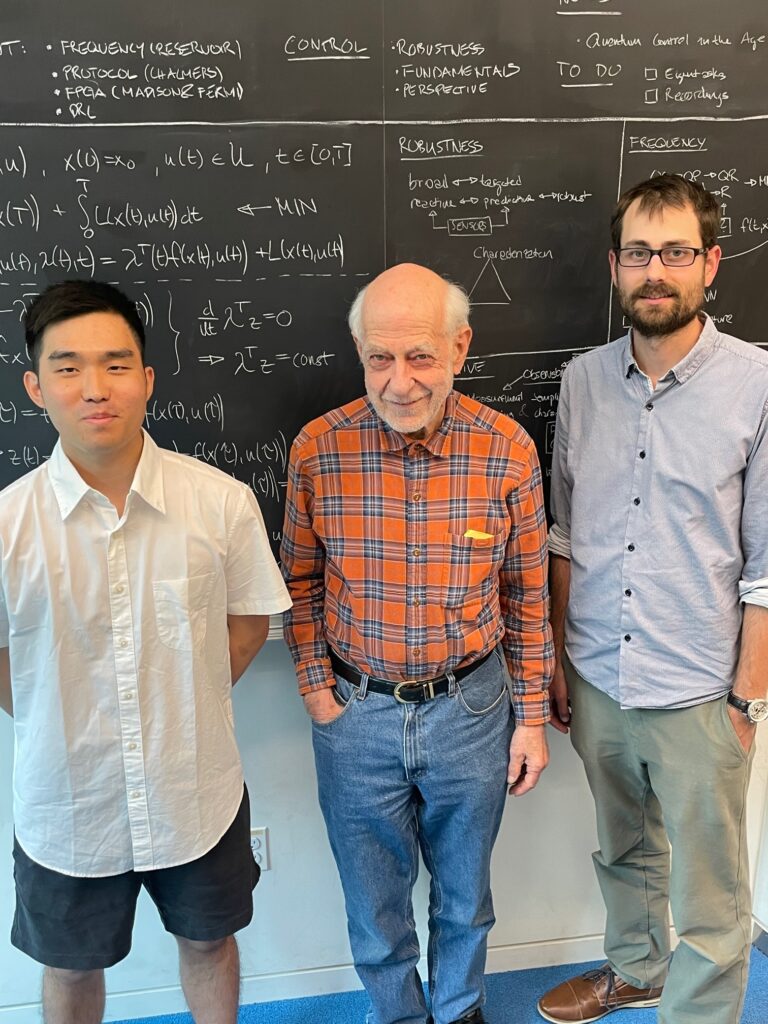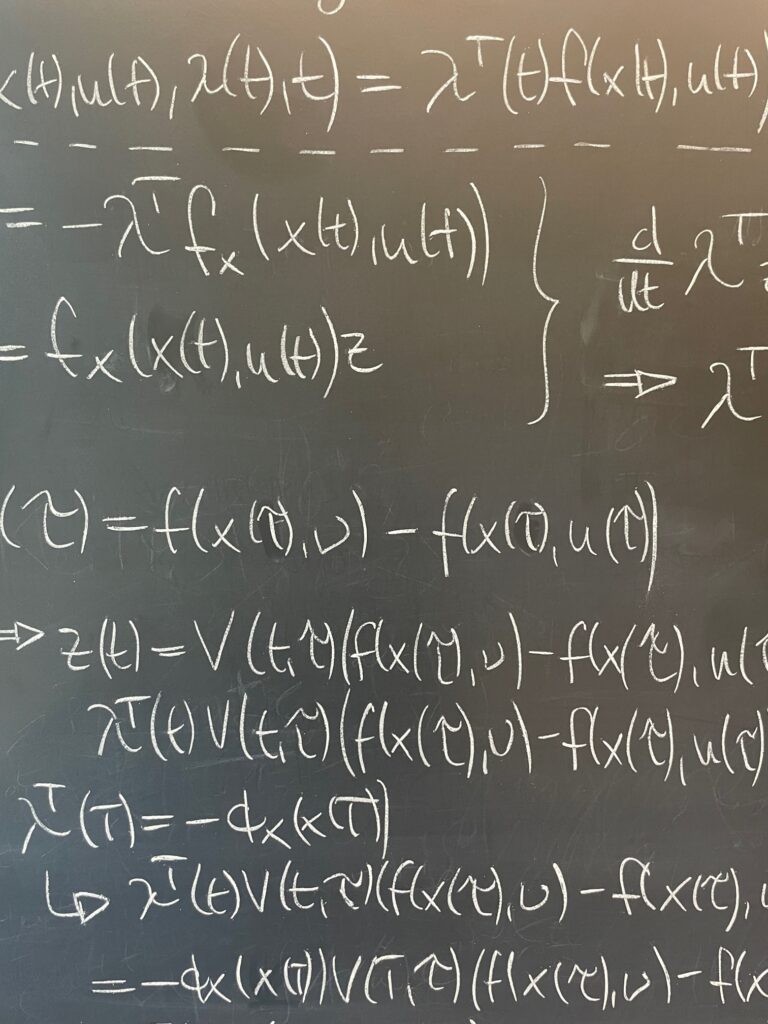Quantum Bootcamp Part IV: An Appreciation of Quantum Mechanics
With this fourth installment in our Quantum Bootcamp series, undergraduates (and non-chemistry concentrators) Wonju Lee and Ethan Wang ‘26 had a lively discussion about lessons they’ve enjoyed so far under the guidance of Department of Chemistry postdoc Benjamin Lienhard of the Rabitz Lab. As a wrap-up at the halfway point of their series, and proof of all they’ve absorbed so far, they selected a few of the most thought-provoking for a quick discussion. (Here are columns one, two, and three.)
Quantum mechanical wave functions; their representation and interpretation
Ethan: In pop culture, we hear a lot about quantum from the Schrödinger’s Cat experiment. Many of the conceptualizations zone in on the idea that before you open the box, the wave function, representing a superposition state, means that the cat is both somehow dead and alive, until you measure it and determine that it has settled in one of those two (eigen) states.
However, the current Copenhagen interpretation of quantum mechanics, as Ben clarified to us and as the Susskind book* explained, is a probabilistic one. Which is to say, under the current prevailing quantum mechanical explanation of this phenomenon, it is not that the cat is both dead and alive at the same time, it is simply that there is a probability that the cat is alive and the cat is dead given the initial set-up of the scenario, and that this superposition describes these probabilities rather than implying that both are true simultaneously.

(From l to r:) Author Wonju Lee, Professor Herschel Rabitz and Ben Lienhard spend a late summer's afternoon at the blackboard.
Wonju: In my experience the importance of the concept that wave functions are probabilistic distributions of eigenstates is often not emphasized enough in classroom settings. I found it interesting that the origin of this interpretation can be traced back to debates between Niels Bohr and Albert Einstein. Bohr proposed that the nature of quantum mechanics is probabilistic. A quantum mechanical object’s wave-particle characteristics collapse to either a wave or particle state upon a measurement by chance, rather than deterministically. Einstein’s response to Bohr’s point of view was famously: “God does not play dice with the universe.”
Max Born’s thought experiment also furthered the probabilistic interpretation, as Ben told us, which I found fascinating. Born thought of a scenario in which a beam of identical particles strike a barrier. The particles interacting with the barrier subsequently scatter in concentric waves. The one interpretation that the particle is “everywhere” was ruled out because the mass of the scattered particles will approach zero as the radius of the concentric waves increases. Instead, Born concluded that the released waves are just a representation of the probabilities of the particles’ position. It is fascinating how nuances of quantum mechanics are rarely discussed. While the Copenhagen interpretation and the associated wave-function collapse is how quantum mechanics is most commonly understood, there are alternate theories and, as of now, no accepted tests to identify the “correct” interpretation.
*Leonard Susskind’s bestselling book, The Theoretical Minimum (published in 2014).
From classical harmonic oscillators to their quantum-mechanical equivalent
Wonju: I recall Ethan mentioning the classical harmonic oscillator in a previous column. While learning about quantum mechanics, we revisited this topic, and compared the classical and quantum harmonic oscillator in detail. Classical and quantum harmonic oscillators are similar in their underlying mathematical framework. They describe an initial and restoring force resulting in oscillations between the different energy states.
However, as we covered in our discussions, there are several fundamental distinctions between classical and quantum oscillators. The state of a quantum oscillator—position or momentum—is characterized by a probability distribution of eigenstates represented by wave functions. The simultaneous measurement of the oscillator’s position and momentum is limited by Heisenberg’s Uncertainty Principle. This is a huge leap from classical mechanics. The motion and position of a classical harmonic oscillator can be precisely and simultaneously determined. Moreover, classical harmonic oscillators have continuous energy values, while its quantum counterpart has quantized energy states, evenly spaced out.
Ethan: These quantum harmonic oscillators can only be measured in certain discrete energy states, and these specific energy levels are determined by Schrödinger’s equation. There are operators that can raise or lower the energy level up the “ladder” of energy levels, along with position and momentum transformed into operators from their classical analogs.
The quantized energy levels are synonymous to the number of photons in the quantized harmonic oscillator, each containing a certain packet amount of energy. This put into perspective for me the scale of quantum harmonic oscillators and quantum physics, as well as giving it a physical example. One more interesting thing for me was the kernel tucked into the diagrams of all the eigenfunctions for various energy levels—all of them had nonzero values stretching out of the graph, technically infinitely.

The blackboard afterwards.
The surprising simplicity of describing quantum mechanics through the lens of linear algebra
Ethan: Something I found particularly surprising upon first learning these concepts was just how easily certain intuitions from linear algebra could be extended to quantum mechanics. For instance, the importance and ideas of eigenstates seemed to map quite easily onto certain parts of measurement and the description of operators. The fact that certain operators could be described as matrices was quite shocking too, and even the concept of entanglement being able to be described through whether a matrix could be a tensor product or not.
Wonju: Though abstract, linear algebra is a unified mechanism for explaining quantum mechanics phenomena. Last semester, we were taking linear algebra while simultaneously studying quantum mechanics, and expectedly, we were immersed in the applications of linear algebra.
The analogy Ben brought up with this elegant and straightforward representation of quantum mechanics via linear algebra was the human language. Historically, civilizations have developed languages to understand and explain the world around them. The description of newly discovered phenomena required an established language. Similarly, physicists have adopted the framework of linear algebra to describe observations at the quantum level. From this view, it is surprising that linear algebra grants such rigor and a high degree of accuracy to explain quantum phenomena.
In column five, we move on to our next rung on the ladder towards the ultimate goal of quantum computing with a focus on quantum optics.
